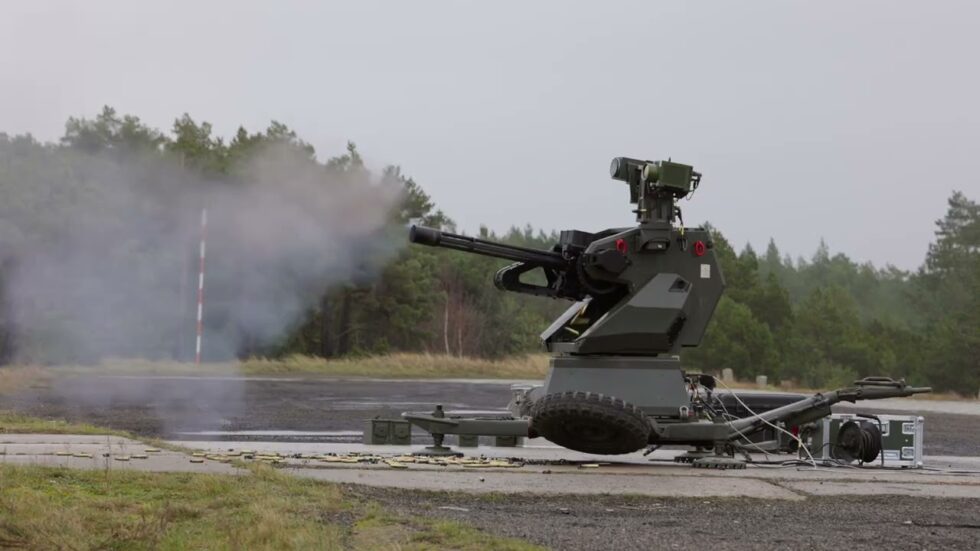Poland has begun equipping its armed forces with a modern drone defense system – the four-barrel WLKM machine gun developed by Zakłady Mechaniczne Tarnów. The weapon was designed in response to the growing threat posed by unmanned aerial vehicles, which in recent years have become one of the key tools in modern conflicts. WLKM is not only intended to protect military bases and ammunition depots, but also to strengthen Poland’s ability to defend critical infrastructure on NATO’s eastern flank. Experts emphasize that the introduction of this system highlights the increasing competence of the Polish defense industry and its ability to deliver independent solutions. According to G.Business, the project is already attracting attention among allied countries.
What is WLKM
WLKM (Wielolufowy Karabin Maszynowy – multi-barrel machine gun) is a Gatling-type four-barrel system chambered in 12.7×99 mm (.50 BMG), designed to counter low-flying aerial targets. Unlike conventional heavy machine guns, its design ensures extremely high rates of fire, significantly increasing the probability of hitting small and agile drones. The weapon can be integrated into various platforms – from stationary defense towers to armored vehicles. This modularity makes WLKM adaptable to changing battlefield conditions. Another key feature is its full compliance with NATO standards, which guarantees compatibility with ammunition and logistics systems.
Main features of WLKM
- four barrels in Gatling configuration,
- caliber 12.7×99 mm (.50 BMG),
- integration on different platforms,
- designed in full compliance with NATO standards.
Technical specifications of WLKM
WLKM was designed for maximum effectiveness against drones and low-altitude aerial threats. It achieves a rate of fire of up to 3,600 rounds per minute, providing a decisive advantage over conventional systems. Its effective firing range extends up to 2,000 meters, with a maximum engagement altitude of approximately 1,500 meters. According to the manufacturer, the weapon is highly reliable and requires limited maintenance, making it suitable for prolonged operational use.
Technical parameters:
- rate of fire: up to 3,600 rounds/minute,
- effective range: up to 2,000 meters,
- engagement ceiling: up to 1,500 meters,
- compatibility: NATO ammunition and spare parts,
- operation: simplified training and low service needs.
How does WLKM counter drones
The strength of WLKM lies in combining a high rate of fire with the power of .50 BMG ammunition. High shot density means that even fast and maneuvering drones are less likely to evade fire. Heavy projectiles deliver destructive kinetic energy, capable of breaking fragile drone structures, damaging onboard electronics, or neutralizing explosive payloads in the case of loitering munitions. In practice, this makes it possible to destroy threats at distances of up to two kilometers without deploying costly missile systems. This offers Poland a rapid, cost-efficient option for defending infrastructure.
Effects of WLKM operation
- increased effectiveness against small and medium drones,
- ability to neutralize loitering munitions,
- protection of critical infrastructure,
- cheaper alternative to missile-based systems.
Where will WLKM be deployed
Poland plans to deploy WLKM primarily within land forces and territorial defense units. Priority areas include military air bases, ammunition storage facilities, and vital logistics hubs. Special focus is given to the eastern border regions – both near Belarus and the Kaliningrad exclave. Thanks to its modular and mobile design, WLKM can be rapidly relocated to threatened areas, providing flexibility and resilience. This is particularly relevant given the increasing number of drone incursions into European airspace.
Planned areas of deployment
- military bases,
- ammunition depots,
- eastern border zones,
- NATO logistics hubs.
Significance for Poland and NATO
The WLKM system plays a key role in Poland’s and NATO’s defense strategy. First, it enhances protection of critical infrastructure, which is increasingly vulnerable to drone attacks. Second, it demonstrates the ability of the Polish defense industry to design and deliver advanced systems within short timeframes. Third, its deployment sends a political signal to NATO allies that Poland is not only a buyer but also a potential supplier of defense technologies. As retired Colonel Marek Stasik noted: “WLKM is more than a tactical tool – it signals that Poland can develop independent modern defense solutions.”
Strategic significance
- strengthening Poland’s and the region’s security,
- showcasing industrial capabilities,
- export potential,
- political signal within NATO.
Export potential and limitations
Thanks to its NATO compliance, WLKM is likely to attract interest from allies seeking cost-effective short-range drone defense systems. However, its effectiveness has limits – it performs best as part of an integrated air defense system. To fully utilize its capabilities, WLKM must be combined with radars and electronic warfare tools. This makes it primarily a tactical weapon, not a stand-alone strategic solution. Still, its relatively low cost and mobility make it appealing to many NATO states.
Pros and cons of WLKM
- lower cost compared to missiles,
- high mobility,
- NATO compatibility,
– limited effectiveness against advanced drones,
– dependent on radar support for optimal results.
Deployment schedule
WLKM has already undergone extensive field testing and proved reliable under operational conditions. Its introduction into land forces and territorial defense is planned for the coming months. Initial units will be stationed in areas particularly vulnerable to drone attacks. The Polish army expects the system to significantly enhance defense on NATO’s eastern flank. NATO partners are expected to closely monitor Poland’s rollout of WLKM, as its success could influence procurement decisions in other allied countries.
Deployment stages
- completed field testing,
- deliveries to land forces and territorial defense,
- deployment to bases and border zones,
- performance evaluation and potential export expansion.
Stay connected for news that works — timely, factual, and free from opinion — and insights that matter now: Flying Wind Generator S1500: China Tests the World’s Largest Airborne Turbine






